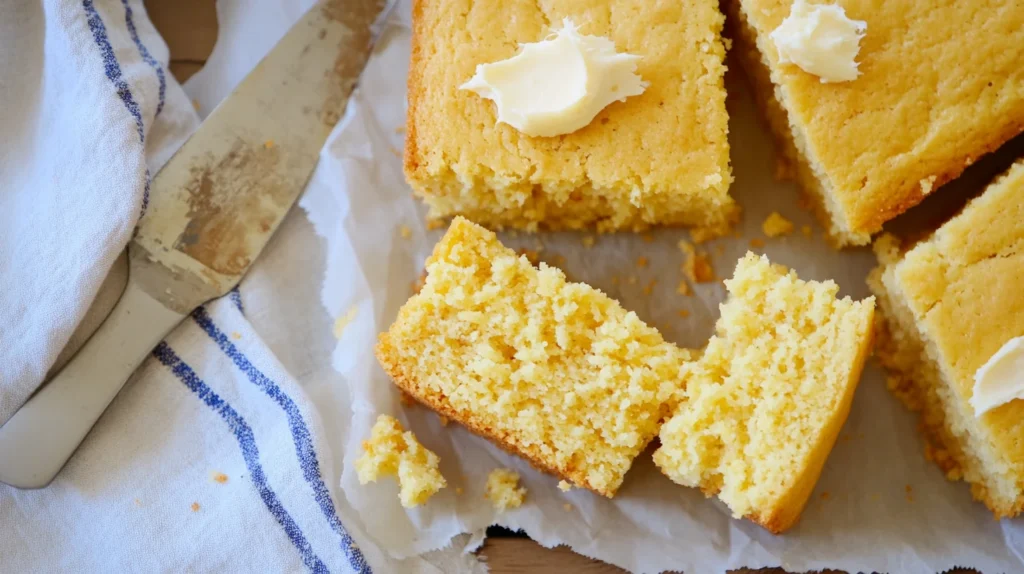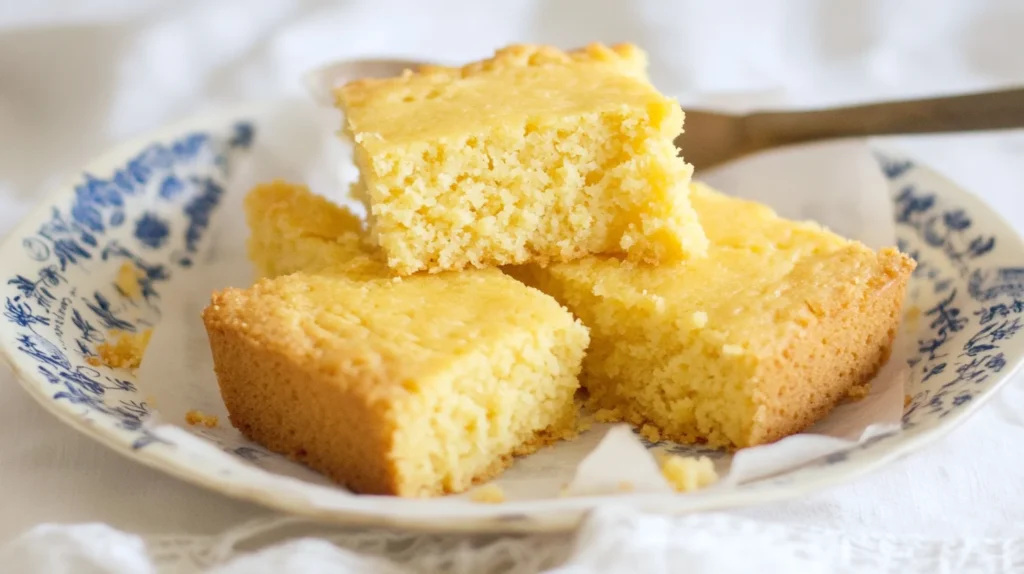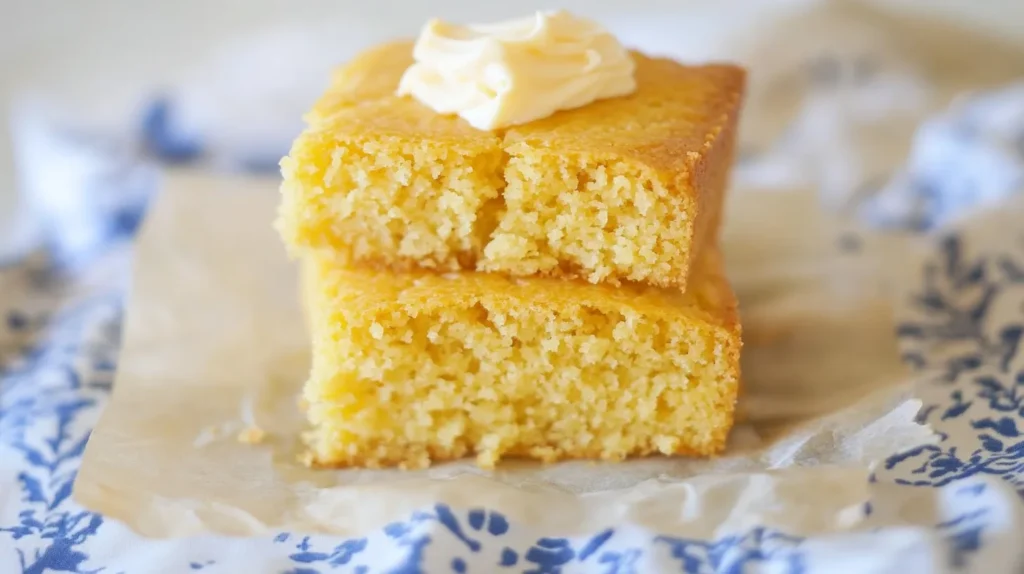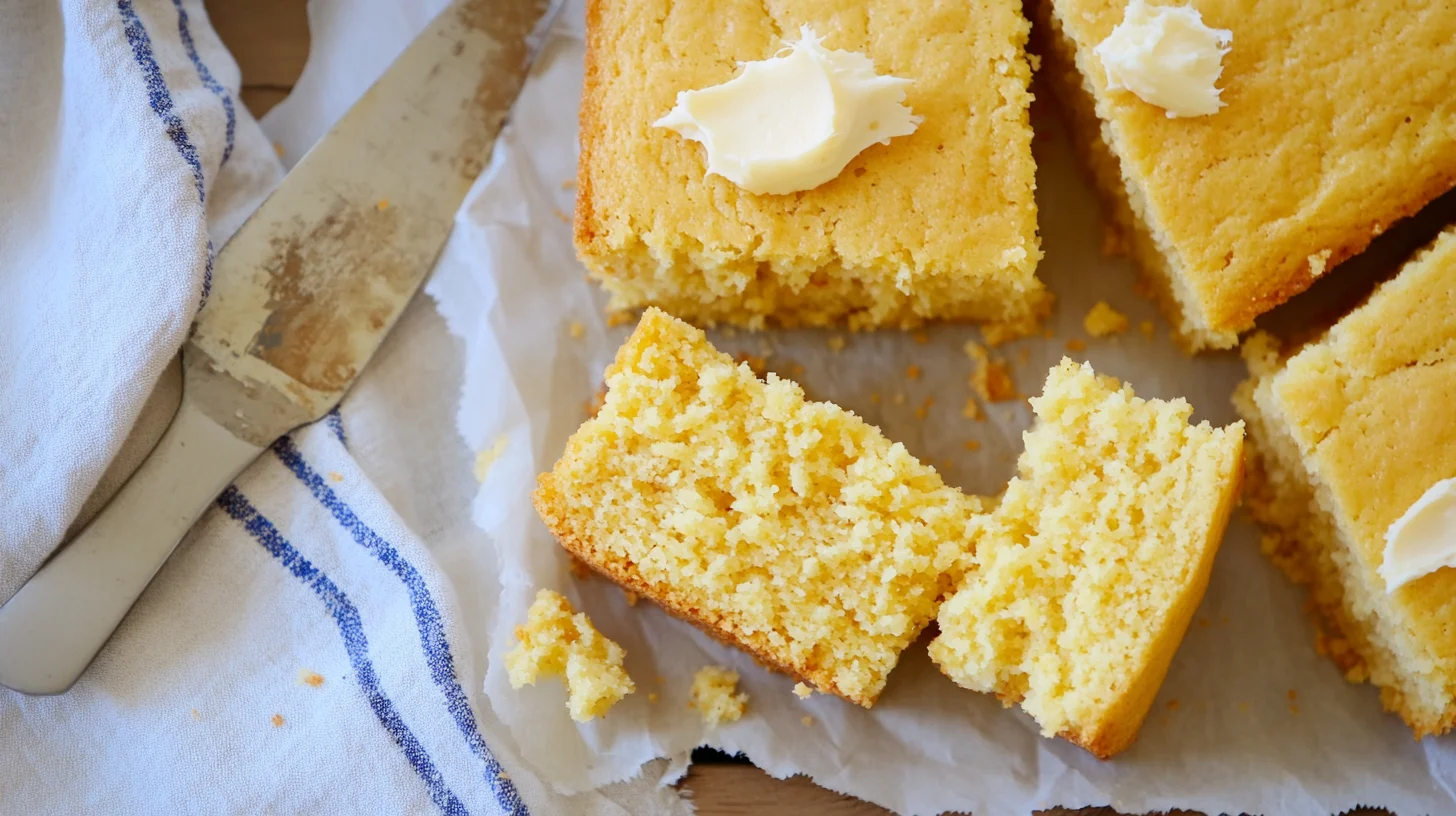I love baking at home, and cornbread is a favorite. But What Happens If You Don’t Add Eggs to Cornbread? This idea might just change how you see cornbread.
Cornbread is loved in many homes. It’s a side dish that goes well with many meals. But what if you skip the eggs? The outcome might amaze you.
Related : No Egg Cornbread Recipe: Simple Southern Classic

Key Takeaways
- Eggless cornbread can still achieve a delightful texture and flavor
- Eggs play a crucial role in binding and moisture retention, which must be addressed
- Proper ingredient substitutions and adjustments can create an equally satisfying cornbread
- Eggless cornbread offers health and cost benefits for those with dietary restrictions or preferences
- Mastering the art of eggless cornbread opens up a world of possibilities for versatile and delicious baking
Understanding the Role of Eggs in Traditional Cornbread
Eggs are key in traditional cornbread, adding texture, moisture, and structure. They play a vital role in the final product.
Binding Properties of Eggs in Baking
In baking, eggs serve as a natural binder, playing a key role in holding the cornbread ingredients together. As the proteins in eggs coagulate during baking, they form a sturdy structure that gives the cornbread its shape and stability, ensuring a well-textured final product.
Moisture Content and Texture Enhancement
Eggs also make cornbread moist and tender. Their high water content prevents drying out. The fats and emulsifiers in yolks add richness and a delicate crumb.
Structural Support in Cornbread
Eggs play a crucial role in providing structural support to cornbread, helping it hold its shape and achieve the ideal rise. This support is essential for creating a sturdy loaf with the perfect crumb and texture, ensuring the cornbread is both tender and well-formed.
Removing eggs from cornbread can affect its texture and structure. It’s important to understand eggs’ role when looking for egg substitutes for cornbread or binding agents for eggless cornbread.

What Happens If You Don’t Add Eggs to Cornbread
Eggs are key in traditional cornbread recipes. But what if you choose to leave them out? Skipping eggs changes the cornbread’s texture, moisture, and structure.
Without eggs, the batter is crumblier and more delicate. Eggs help the cornbread stay together. Without them, it might fall apart or crumble easily.
Eggs also keep cornbread moist. Without them, it can dry out and become staler. The texture becomes coarse and dense, losing the soft crumb eggs provide.
Lastly, eggs help cornbread rise and keep its shape. Without them, it might not rise as much. It could look denser and more compact.
| Characteristic | Cornbread with Eggs | Eggless Cornbread |
|---|---|---|
| Texture | Tender and moist | Crumbly and delicate |
| Moisture Content | Retains moisture well | Prone to drying out |
| Structure | Rises well and maintains shape | Denser and more compact |
Not adding eggs to cornbread changes its texture, moisture, and structure. Knowing these changes helps when baking eggless cornbread. You can adjust your recipe to get the best results.

Common Texture Changes in Eggless Cornbread
When you make cornbread without eggs, you might notice some changes. These changes can affect how the cornbread feels and looks. Knowing about these changes can help you fix them when making eggless cornbread.
Crumbliness and Structure Issues
Eggless cornbread often tends to feel crumblier because it lacks the binding properties that eggs provide. Eggs play a crucial role in holding the cornbread together, creating a cohesive texture that makes it easier to cut and serve. Without them, the cornbread may fall apart more easily, which can make serving it neatly a bit more challenging. By addressing this with proper substitutes, you can still achieve a well-structured eggless cornbread.
Moisture Retention Challenges
Moist eggless cornbread might also be drier. Eggs add moisture and prevent the cornbread from getting too dense. Without eggs, it can dry out faster, changing how it tastes and feels.
Impact on Rise and Density
Eggs also help the cornbread rise and feel lighter. Without them, the cornbread might be denser. It could feel heavier and more compact.
Knowing about these changes can help you make better eggless cornbread. You can try different ingredients and baking methods to get the right texture. Finding the right egg substitutes is key to solving these problems.
Best Egg Substitutes for Cornbread
No need to worry if you’re baking cornbread without eggs! There are plenty of excellent substitutes available to replicate the binding, moisturizing, and leavening properties that eggs provide. Whether you opt for commercial egg replacers or natural alternatives, there’s a solution to suit your needs. With this guide, you’ll learn how to choose the best substitute and create delicious, tender eggless cornbread that’s every bit as satisfying as the traditional version.
Commercial Egg Replacers
- Powdered egg replacers: These products are made to act like eggs in baking. They mix starches, leavening agents, and binders.
- Flax or chia “eggs”: Mix 1 tablespoon of ground flax or chia seeds with 3 tablespoons of water. This makes a gel that can replace one egg.
- Aquafaba (chickpea liquid): The liquid from a can of chickpeas works well as an egg substitute. It adds structure and binds.
Natural Binding Agents
For whole food ingredients, try these as egg substitutes for cornbread:
- Mashed banana or applesauce: These add moisture and bind in cornbread recipes.
- Ground nuts or nut butters: Almond flour, ground flaxseeds, or nut butters replace eggs’ binding.
- Silken tofu: Blended silken tofu can mimic eggs’ texture and structure.
Selecting the right egg replacer for your cornbread is an important step, so take your time to choose wisely. Don’t hesitate to experiment with different substitutes and adjust the recipe as needed to achieve the perfect texture and rise. With a little patience and some trial and error, you’ll soon master the art of making eggless cornbread that’s just as delicious and satisfying as the original.
Plant-Based Alternatives for Binding in Cornbread
When baking vegan cornbread without eggs, finding the right binders is key. Luckily, there are many plant-based options that work great. They help your cornbread turn out just right.
Flax and Chia Seeds
Ground flax seeds and chia seeds are top picks for egg substitutes. Mix them with water, and they create a gel that acts like eggs. Use 1 tablespoon of ground flax or chia with 3 tablespoons of water. Let it sit for a few minutes before adding it to your egg alternatives in baking.
Commercial Egg Replacers
When it comes to baking without eggs, commercial egg replacers are a convenient and reliable choice. These products are typically made from a combination of starches, gums, and leavening agents, allowing them to effectively replicate the role of eggs in your recipe. Simply follow the package instructions to use them as a direct substitute in your vegan cornbread, ensuring consistent texture and rise every time.
Natural Binding Agents
For a more natural approach, consider using ingredients like applesauce, mashed bananas, or ground nuts and nut butters as binders in your vegan cornbread. Not only do these alternatives help hold the ingredients together, but they also contribute to a moist and tender texture while adding unique flavors to your dish. By exploring these options, you can create delicious eggless cornbread with a personal touch.
| Binding Agent | Ratio to Replace 1 Egg | Notes |
|---|---|---|
| Ground Flax Seeds | 1 tbsp + 3 tbsp water | Forms a gelatinous mixture |
| Ground Chia Seeds | 1 tbsp + 3 tbsp water | Forms a gelatinous mixture |
| Commercial Egg Replacer | Varies, see package instructions | Designed for egg-free baking |
| Applesauce | 1/4 cup | Adds moisture and binds |
| Mashed Banana | 1/2 medium banana | Provides natural sweetness |
| Ground Nuts or Nut Butter | 2-3 tbsp | Adds richness and structure |
Using these plant-based alternatives, you can make delicious vegan cornbread without eggs.
Tips for Making Moist Eggless Cornbread
Making moist eggless cornbread is a fun challenge. With the right techniques, you can make it tender and flavorful. These tips will help your egg-free cornbread stay moist and delicious, whether you’re baking for dietary reasons or just to try something new.
- Adjust the liquid-to-dry ingredient ratio: To compensate for the absence of eggs, increase the amount of liquid ingredients, such as milk or non-dairy alternatives, in your recipe. This adjustment helps maintain the right consistency and ensures your eggless cornbread stays moist and tender, preventing it from becoming too dry.
- Incorporate additional binding agents: Use ground flaxseed, chia seeds, or commercial egg replacers. They help the batter stick together and prevent it from crumbling.
- Avoid over-mixing the batter: Overmixing can make the cornbread tough. Just gently fold the ingredients together until they’re just combined.
- Bake at a lower temperature for longer: This slow cooking method helps the moist eggless cornbread cook evenly without drying out.
- Cover the cornbread during baking: A loose foil tent over the pan traps moisture. It keeps the surface from drying out.
- Let the cornbread cool completely before slicing: Cooling it completely helps the crumb set. This prevents the eggless cornbread from falling apart when you slice it.
Follow these tips to make moist eggless cornbread that’s not only tasty but also meets dietary needs or personal preferences.
| Ingredient | Traditional Cornbread | Eggless Cornbread |
|---|---|---|
| Eggs | 2-3 | 0 |
| Milk | 1 cup | 1 1/4 cup |
| Cornmeal | 1 cup | 1 cup |
| Flour | 1 cup | 1 cup |
| Baking Powder | 1 tbsp | 1 1/2 tbsp |
| Salt | 1/2 tsp | 1/2 tsp |
| Sugar | 2 tbsp | 2 tbsp |
“The secret to moist and flavorful eggless cornbread lies in the balance of ingredients and baking technique. With a few simple adjustments, you can create a cornbread that is just as satisfying as the traditional version.”
Adjusting Recipe Proportions for Egg-Free Cornbread
When baking eggless cornbread, you need to adjust the recipe to get it right. Eggs help bind and add moisture. So, you’ll need to make some changes to get the right texture and structure.
Liquid-to-Dry Ingredient Ratio
In traditional cornbread recipes, eggs play a vital role by binding dry ingredients together and adding much-needed moisture. When making cornbread without eggs, it’s essential to compensate by increasing the liquid content. You can achieve this by adding a little extra milk, buttermilk, or plant-based milk to the batter. To ensure the perfect consistency, aim for a liquid-to-dry ingredient ratio of about 1:2 or 1:2.5. By making this small adjustment, you’ll create eggless cornbread that’s just as moist and delicious as the classic version.
Leavening Agent Modifications
Eggs also help cornbread rise and get its texture. To get the right lift and texture without eggs, adjust the leavening agents. Start by adding 25-50% more baking powder or baking soda. Then, adjust as needed.
| Ingredient | Traditional Cornbread | Eggless Cornbread |
|---|---|---|
| Liquid | 1 cup | 1-1.25 cups |
| Baking Powder | 1 tablespoon | 1.25-1.5 tablespoons |
By adjusting the liquid and leavening agents, you can make a tasty eggless cornbread. It will have the classic texture and rise you love.
Common Mistakes to Avoid in Eggless Cornbread
Baking egg-free cornbread is a fun and healthy choice. But, it’s key to avoid common mistakes for the best result. As you start your eggless cornbread recipe adventure, remember these tips to make a cornbread that’s a real winner.
Overmixing the Batter
One big mistake in eggless cornbread baking is overmixing the batter. This can make the cornbread tough and dense. Just mix the ingredients gently until they’re just combined. Don’t stir or beat too much.
Incorrect Substitute Ratios
When you substitute eggs in cornbread, getting the right amounts is crucial. If you don’t adjust the other ingredients, your cornbread might be crumbly or dry. Try different egg replacers and adjust the liquid and flour as needed.
Baking Temperature Errors
Temperature plays a critical role in successfully baking eggless cornbread. Baking it for too long can result in a dry, crumbly texture, while baking it for too short a time can leave it gummy and undercooked. To achieve the perfect balance, monitor your oven temperature and baking time carefully. This attention to detail ensures a beautifully golden-brown crust paired with a moist, tender interior.
By steering clear of these common pitfalls and following the right techniques, you’ll consistently bake delicious, egg-free cornbread that’s sure to impress every time. With practice and precision, this classic dish will become a reliable favorite in your kitchen.
Benefits of Making Cornbread Without Eggs
Cornbread is a favorite for many, but it can be hard to make without eggs for vegans or those with egg allergies. The good news is you can still enjoy delicious cornbread without eggs. Making vegan cornbread or egg-free cornbread lets you enjoy this treat while meeting your dietary needs.
Health and Dietary Advantages
Not using eggs in cornbread has many health benefits. It’s safe for those with egg allergies or sensitivities. It also lets vegans enjoy this classic dish without breaking their diet.
Cost and Accessibility Benefits
Choosing a vegan cornbread recipe can also save money and be easier to find ingredients for. Eggs can be pricey, but plant-based substitutes like flax or chia are cheaper. This way, you can make the same tasty cornbread without spending more.
Also, using egg-free cornbread ingredients makes it easier for more people to enjoy. It includes those who can’t eat eggs due to dietary restrictions or preferences.
Looking for a healthier option, accommodating dietary needs, or saving money? Making cornbread without eggs has clear benefits. With the many egg-free alternatives out there, you can enjoy the comforting taste of cornbread while meeting your dietary needs.
Storage and Shelf Life of Eggless Cornbread
Storing your eggless cornbread is similar to traditional cornbread, but with some differences. It’s crucial to keep the bread fresh for a longer time.
Let your cornbread without eggs cool down completely before storing. This step prevents moisture buildup, which can cause mold and a soggy texture. After cooling, wrap it tightly in plastic wrap or foil, or use an airtight container.
Eggless cornbread has a shorter shelf life than traditional cornbread. It’s best to eat it within 2-3 days at room temperature. For longer freshness, store it in the fridge for up to a week.
To freeze eggless cornbread for up to 3 months, wrap it well in plastic or foil, or use a freezer-safe bag. Thaw it at room temperature or in the fridge before enjoying.
Proper storage plays a crucial role in preserving the freshness of your eggless cornbread. By following these simple yet effective tips, you can maintain its moist texture and delicious flavor for several days, ensuring it’s just as enjoyable as when it was freshly baked.
Conclusion
Making cornbread without eggs is not only possible but also offers benefits. It’s great for those with dietary restrictions, looking to save money, or wanting to try new recipes. Exploring eggless cornbread baking is definitely worth it.
Understanding the role eggs play in cornbread is key to finding the best substitutes and achieving the perfect balance in your recipe. By doing so, you can create moist, flavorful, and structurally sound eggless cornbread. The tips and techniques shared here will guide you in mastering the nuances of baking cornbread without eggs, allowing you to craft a delicious egg-free version that rivals the original.
Don’t hesitate to explore different techniques and experiment with various ingredients to discover your go-to eggless cornbread recipe. With a little creativity and an open mind, you’ll soon be able to bake egg-free cornbread that’s so good, it will quickly become a favorite among family and friends.
FAQ
What happens if you don’t add eggs to cornbread?
Without eggs, the texture and structure of cornbread can change significantly. It may turn out crumbly, dense, or even dry, as eggs play a vital role in retaining moisture and binding the ingredients together. By understanding this change, you can explore adjustments to recreate the traditional cornbread’s tender and cohesive texture.
What are some egg substitutes for cornbread?
You can use flax or chia seeds, commercial egg replacers, or mashed banana. Applesauce and a mix of baking soda and vinegar also work. These help replace eggs’ binding and moistening effects.
Can you make an eggless cornbread recipe?
Yes, you can make a tasty eggless cornbread. Just adjust the ingredients and use egg substitutes to get the right texture and structure.
What are some common texture changes in eggless cornbread?
Eggless cornbread might be more crumbly and harder to keep moist. It can also be denser without eggs’ help in rising and keeping its shape.
What are the best egg alternatives for binding in cornbread?
To achieve the perfect binding in cornbread, flax or chia seeds, commercial egg replacers, and natural binders like xanthan gum or arrowroot powder are excellent options. These substitutes effectively hold the batter together, mimicking the role eggs play in traditional recipes, while adding their own subtle benefits to the mix.
How can you make eggless cornbread moist?
To keep eggless cornbread moist and flavorful, focus on adjusting the liquid-to-dry ingredient ratio for the perfect consistency. Incorporate extra-moist ingredients such as applesauce or yogurt to enhance texture. Additionally, avoid over-baking, as this can dry out the cornbread, and store it properly to preserve its moisture for longer enjoyment.
How do you adjust a traditional cornbread recipe to be egg-free?
Transforming a traditional cornbread recipe into an egg-free version requires a few thoughtful adjustments. Start by modifying the liquid-to-dry ingredient ratio to maintain the right consistency. Replace eggs with suitable substitutes, such as flaxseed meal or applesauce, and experiment with baking soda or baking powder amounts to ensure the cornbread rises beautifully. With these tweaks, you can create a delicious eggless version of this classic dish.
What are some common mistakes to avoid when making eggless cornbread?
Avoid overmixing the batter and using the wrong substitute ratios. Baking at the wrong temperature can also mess it up. Paying attention to these details is key to a successful eggless cornbread.
What are the benefits of making cornbread without eggs?
Making cornbread without eggs is healthier for those with egg allergies or following vegan diets. It’s also cheaper and easier to find ingredients.
How should eggless cornbread be stored?
Store eggless cornbread like traditional cornbread, but it might not last as long. Keep it in an airtight container at room temperature. Eat it within a few days for the best taste.

